Capacity utilization is a critical metric in the manufacturing world, reflecting the extent to which an organization leverages its fixed production assets. It’s the heartbeat of operational efficiency, indicating whether a company is maximizing its resources or potentially experiencing cost leaks due to underutilization. For decision-makers, understanding how to measure and optimize capacity utilization can lead to informed strategies that drive productivity and profitability. In an increasingly competitive market, mastering this aspect can become a company’s significant edge. Below, we delve into the intricacies of capacity utilization and how businesses can harness its full potential.
Understanding Capacity Utilization in Manufacturing Industries
Alt text: A storage facility that uses capacity utilization for a more optimized manufacturing and storing process.
Capacity utilization is a crucial metric in the manufacturing industry, indicating the percentage of potential output being realized. It is a test of operational efficiency and provides insight into the productive use of factory resources. High utilization rates indicate near-maximum use of physical capabilities, leading to economies of scale and lower unit costs. Low utilization can reveal issues in production processes, inefficiencies, or mismatches between demand and output capabilities.
Understanding capacity utilization involves acknowledging external and internal factors affecting production, such as market demand, supply chain issues, and machinery downtime. This comprehensive view helps managers adjust processes, scheduling, and maintenance practices to fit the current business climate. Capacity utilization is also a tool for strategic decision-making, allowing businesses to plan capital investments, workforce training, and expansions with confidence.
Key Benefits of Measuring Capacity Utilization
Capacity tracking is crucial for strategic planning and ensuring a company’s assets are being used effectively. It helps identify cost-saving opportunities, allowing for the identification of production inefficiencies and resulting in lower operational costs. This continuous improvement promotes competitiveness and reduces waste, energy consumption, and carbon footprint.
Optimizing capacity is also linked to responsible use of resources, promoting environmentally conscious manufacturing practices. The benefits of capacity tracking extend beyond manufacturing, enhancing customer satisfaction by ensuring faster order fulfillment and reliable delivery schedules. Capacity tracking is essential for maintaining client trust and promoting sustainable practices.
Strategies for Optimizing Capacity Utilization
Capacity optimization involves identifying production bottlenecks, such as machine limitations, labor skills, or workflow design, to focus on areas for improvement. Lean manufacturing and Six Sigma can streamline operations. Demand forecasting helps producers align output with market expectations, allowing for efficient inventory management and avoiding overproduction and stockouts.
Maintenance schedules also impact capacity utilization, with proactive and preventive maintenance minimizing unplanned downtime. Scheduling activities outside peak production times ensures high utilization rates. Workforce management, including cross-training employees and flexible work patterns, helps stabilize output levels and maintain high utilization rates even under dynamic market conditions.
Technological Tools to Track and Improve Capacity Usage
Alt text: An industrial IT worker analyzing predictive analytics on a computer.
Technology is crucial in optimizing capacity, with advanced analytics platforms revealing insights that human planners may overlook. Manufacturers are using software solutions for real-time monitoring of capacity utilization, providing dashboards with key performance indicators. IoT devices, which gather continuous data streams, enable predictive analytics and preemptive decision-making regarding maintenance and production schedules.
Artificial Intelligence and Machine Learning algorithms are revolutionizing capacity optimization by forecasting potential future scenarios, allowing manufacturers to adjust their processes proactively, leading to enhanced capacity utilization. These technologies are enabling manufacturers to maintain operational flow and enhance their capacity utilization.
Overcoming the Challenges of Capacity Utilization Measurement
Capacity utilization measurement is a complex task that requires precise data collection, analysis, and interpretation. It’s especially challenging in outdated systems or seasonal demand patterns. To overcome these challenges, manufacturing entities should invest in reliable data collection methods and robust analytic tools. Consistency in measurement and reporting allows for trustworthy trends for business decisions.
Fostering a culture of continuous improvement and capacity consciousness can help identify inefficiencies. Engaging and training employees can maximize utilization rates. When resistance to change arises, clear communication and training can help. Emphasizing the link between capacity management and job security or corporate success can encourage workforce participation.
Overall, capacity utilization is crucial for manufacturing businesses to maintain competitiveness and profitability. It enhances cost control, productivity, and sustainability. With the right strategies, tools, and mindset, manufacturers can transform capacity utilization into a growth opportunity for success.







